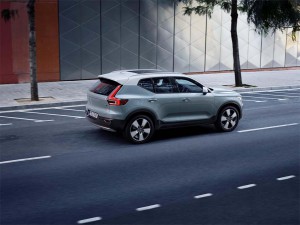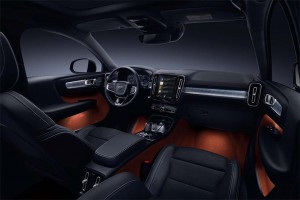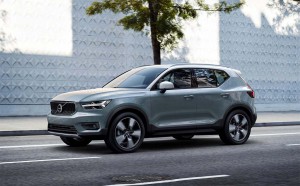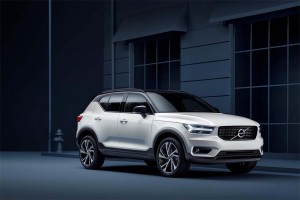Volvo is rapidly fleshing out its showrooms, and with the launch of the new XC40 sport-utility vehicle it is taking aim at one of the world’s fastest-growing market segments.
The new crossover follows in the tire tracks of the well-received XC90 and XC60 models and marks the debut of an all-new Compact Modular Architecture, or CMA platform, that will be used for a range of additional, downsized products to come over the next several years. It also helps Volvo introduce the new “Care by Volvo” program that, the maker claims, could help redefine the car buying and ownership experience.
“The XC40 is our first entry in the small SUV segment, broadening the appeal of the Volvo brand and moving it in a new direction,” said Volvo Cars CEO Hakan Samuelsson during a preview of the new model in Milan on Thursday.
Volvo has aggressively expanded its line-up since the Swedish-based automaker was purchased from Ford Motor Co. by Zhejiang Geely Holding Co. in 2010. The Chinese company has so far invested more than $6 billion into Volvo and built two new assembly plants in China for it. A third plant is set to open in Charleston, South Carolina, next year. And, as TheDetroitBureau.com yesterday reported, Volvo is already planning to double the size of its first U.S. factory at an estimated cost of around $1 billion.
(Volvo set to double size of Charleston plant a year before it opens. For the story, Click Here.)

Volvo is filling the gaps in its product portfolio to make it competitive. The new XC40 is the latest effort.
The new XC40 will roll off one of Volvo’s older plants, a factory in Ghent, Belgium, however. And it will target a fast-growing, albeit increasingly crowded compact crossover segment. Key competitors include the Mercedes-Benz GLA, the BMW X1 and Audi Q3, as well as the Lexus NX and the E-Pace, the second SUV to be launched by another former Ford luxury brand, Jaguar.
Volvo hopes to stand out by offering a mix of in-vehicle features, an assortment of green, or at least greener, powertrains, and the sort of advanced safety technologies the brand has long been known for.
Significantly, where Volvo was long known for its boxy wagons, it has shifted focus to sleeker utility vehicle. In fact, the V90 wagon is only being offered in the U.S. by special order.
The XC40 picks up on the basic design cues first seen on the XC90 and XC60 models. That starts with the broad grille and the brand’s “iron mark” logo, framed by slit-like headlamps featuring LED “Thor’s Hammer” daytime running lights.
The XC40 has a more aggressive look, overall, however, with more sharply defined creases and curves and a floating roofline. That is, in part, the result of the shorter wheelbase that gives the ute a more punchy appearance.
“A family look doesn’t necessarily mean they all look like each other,” said Thomas Ingenlath, Volvo’s design chief.
Under the skin, the new CMA platform will supplement the original large-car architecture used for Volvo’s 90- and 60-Series models. It will show up on a variety of new products, including several expected to be revealed next year. The CMA platform was jointly developed with parent and also will be used for products being developed for both the Geely brand and the new, mid-range Lynk & Co. brand recently introduced in China.
(Click Here for more on Volvo’s electrification strategy.)
Inside, the new model adopts a more lavish and elegant look than the brand’s older compact entries, and the XC40 adopts the distinctive, portrait-shaped touchscreen used to control the car’s infotainment system and a number of other onboard technologies.
That includes a raft of conventional safety systems and more advanced driver assistance systems, or ADAS, technologies. That includes Volvo’s Pilot Assist system, City Safety, Run-off Road Protection and Mitigation, Cross Traffic Alert with brake support, and a surround-view camera that makes it easier to park.

The new model adopts a more lavish and elegant look than the brand’s older compact entries, and the XC40 adopts the distinctive, portrait-shaped touchscreen.
One of the more intriguing features Volvo is launching with the XC40, however, isn’t actually built into the car itself. The automaker has been studying a variety of new services to enhance both the car-buying and ownership experience. The V90 wagon, for example, can be ordered in the U.S. online. In Europe, Volvo has developed a process allowing package delivery services to access a vehicle to load goods into one of its vehicles, making it easier to get a delivery when one is at work or otherwise away from home.
The XC40 will introduce the new “Care by Volvo” service which, Volvo explained in a statement, “makes having a car as transparent, easy and hassle free as having a phone.”
Loosely based on the leasing concept, customers will be able to opt for a flag monthly “subscription” fee, without a down payment or price negotiations. Under the plan, owners will be able to upgrade to a new Volvo in as little as 12 months.
The Care program will also include digital services including free pick-up and delivery for service, and the program is designed to allow car-sharing using a new digital key technology.
(Why are Volvo’s top executives swapping jobs? Click Here to find out.)
Volvo also said the new XC40 will be available for ordering online in many countries, and that feature may be extended to the U.S., though the transaction will have to be completed through a dealer due to American franchise laws. Details of the U.S. version of the Care by Volvo program, including pricing for the new XC40, will be announced at the Los Angeles Auto Show in November.


